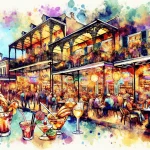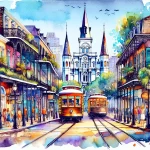New Orleans captivates visitors with its distinctive neighborhoods, each embodying a unique cultural identity and architectural style. To truly appreciate the essence of the Crescent City, exploring these vibrant districts is essential.
In This Article
TL;DR
- New Orleans comprises diverse neighborhoods, each with its own distinct architecture, culture, and history.
- Understanding the local heritage and traditions of each area is crucial for fully immersing yourself in the New Orleans experience.
- Practical tips, such as using public transportation, respecting local customs, and seeking immersive experiences, can enhance your exploration of these neighborhoods.
French Quarter: The Historic Heart
The French Quarter, or Vieux Carré, is the oldest and most iconic neighborhood in New Orleans. Its architecture is a captivating blend of Spanish, French, and Creole influences, adorned with wrought-iron balconies, colorful facades, and hidden courtyards. Jackson Square, a historic park encompassed by the iconic St. Louis Cathedral, the Cabildo (former Spanish government seat), and the Presbytère (now a museum), forms the heart of the French Quarter.
The French Market, a bustling open-air market dating back to 1791, offers a variety of local goods, fresh produce, and culinary delights. Don’t miss the renowned Café du Monde (800 Decatur St, New Orleans, LA 70116, open 24/7), known for its chicory coffee and beignets.
The French Quarter hosts New Orleans’ cultural events and festivals, such as Mardi Gras and the French Quarter Festival. During Mardi Gras, the streets come alive with vibrant parades, elaborate costumes, and lively music.
Garden District: Lush and Luxurious
The Garden District exemplifies New Orleans’ antebellum opulence, with grand mansions and lush gardens. Greek Revival and Italianate architectural styles dominate the neighborhood, with notable examples being the Commander’s Palace (1403 Washington Ave, New Orleans, LA 70130, open for lunch and dinner) and the Buckner Mansion.
Magazine Street, the heart of the Garden District, is a shopper’s paradise lined with boutiques, antique shops, and art galleries. For a taste of local cuisine, try the famous turtle soup at Commander’s Palace or the shrimp and grits at Atchafalaya (901 Louisiana Ave, New Orleans, LA 70115, open for brunch and dinner).
The Garden District is renowned for its Mardi Gras celebrations, with the prestigious Krewe of Rex parading through the neighborhood on Mardi Gras day.
Bywater: Artistic and Eclectic
Once a working-class district, Bywater has transformed into a vibrant arts community. Colorful shotgun houses and converted warehouses now house art galleries, studios, and trendy restaurants.
Crescent Park, a 1.4-mile linear park along the Mississippi River, offers stunning views of the city skyline and is a popular spot for picnics and outdoor events. The New Orleans Center for Creative Arts (2800 Chartres St, New Orleans, LA 70117), a prestigious arts high school, has nurtured many of the city’s talented artists and musicians.
The Bywater hosts community events like the Bywater Mirliton Festival, celebrating the neighborhood’s creativity and local produce.
Marigny: Music and Nightlife
Adjacent to the French Quarter, the Marigny neighborhood is renowned for its vibrant music scene and nightlife. Frenchmen Street, the main artery, is lined with live music venues like The Spotted Cat (623 Frenchmen St, New Orleans, LA 70116, open daily from 2 pm), where you can enjoy jazz, blues, and funk performances.
The interaction between local musicians and the community is a defining feature of the Marigny. Impromptu street performances and jam sessions are common, creating an atmosphere of spontaneity and creativity.
Annual events like the Frenchmen Street Festival and the Marigny Mardi Gras parade showcase the neighborhood’s musical heritage and community spirit.
Tremé: Rich African American Heritage
Tremé, one of the oldest African American neighborhoods in the United States, has played a significant role in shaping New Orleans’ cultural identity and the development of jazz. The neighborhood is home to Armstrong Park, named after the legendary jazz musician Louis Armstrong, which hosts jazz concerts and cultural events.
The Backstreet Cultural Museum (1116 Henriette Delille St, New Orleans, LA 70116, open Tue-Sat 10am-4pm) is dedicated to preserving Tremé’s African American history and traditions, with exhibits on Mardi Gras Indians, jazz funerals, and second-line parades.
Tremé’s annual Mardi Gras Indian parades, where elaborately costumed tribes march through the streets, are a testament to the neighborhood’s cultural resilience and preservation efforts.
Mid-City: The Heart of New Orleans
Mid-City, as its name suggests, is geographically and culturally central to New Orleans. The neighborhood is home to City Park, one of the largest urban parks in the United States, which features the New Orleans Museum of Art (1 Collins Diboll Cir, New Orleans, LA 70124, open Tue-Sun 10am-5pm), the Sydney and Walda Besthoff Sculpture Garden, and the New Orleans Botanical Garden.
Mid-City’s culinary scene reflects its diversity, with standout restaurants like Toups’ Meatery (845 N Carrollton Ave, New Orleans, LA 70119, open for lunch and dinner) for contemporary Cajun fare and Parkway Bakery & Tavern (538 Hagan Ave, New Orleans, LA 70119, open Wed-Mon 11am-4pm) for classic po’ boys.
The neighborhood hosts several food festivals throughout the year, such as the Mid-City Bayou Boogaloo, celebrating local music, art, and cuisine along the banks of Bayou St. John.
Uptown and Audubon: University Life and Upscale Living
Uptown, home to Tulane and Loyola Universities, has a youthful, academic vibe. The presence of the universities influences the neighborhood’s atmosphere, with a mix of student hangouts, coffee shops, and bookstores.
Audubon Park, designed by renowned landscape architect John Charles Olmsted, offers a tranquil escape from the city, with its sprawling green spaces, jogging paths, and the Audubon Zoo (6500 Magazine St, New Orleans, LA 70118, open daily 10am-5pm), a popular family-friendly attraction.
The Uptown neighborhood is also known for its historical and cultural tours, such as the St. Charles Avenue streetcar tour, which takes visitors past grand mansions and historic landmarks.
Algiers Point: Quiet Charm Across the River
Algiers Point, located on the west bank of the Mississippi River, offers a serene escape from the city’s hustle and bustle. The neighborhood’s historic homes, some dating back to the 19th century, showcase a mix of architectural styles, from Victorian to Craftsman.
The Algiers Point Ferry, departing from the foot of Canal Street, provides a scenic link to the French Quarter, with stunning views of the New Orleans skyline along the way.
The neighborhood’s local music scene is centered around intimate venues like the Old Point Bar (545 Patterson St, New Orleans, LA 70114, open daily 11am-late), where you can catch live performances by local artists.
Practical Tips for Exploring New Orleans Neighborhoods
Utilize public transportation, such as the streetcars and buses, to efficiently navigate between neighborhoods. The RTA (Regional Transit Authority) offers day passes and multi-day passes for unlimited rides.
Exercise caution, especially in the French Quarter and surrounding areas at night. Stick to well-lit, populated streets and avoid walking alone in unfamiliar areas.
Respect local customs and traditions, particularly during Mardi Gras and other cultural events. Dress appropriately, follow parade etiquette, and be mindful of private property.
Seek out immersive experiences, such as cooking classes, music workshops, and historical tours, to gain a deeper understanding of each neighborhood’s unique culture and heritage.
By exploring these diverse neighborhoods, you’ll uncover the true essence of New Orleans, a city that celebrates its rich history, vibrant culture, and resilient spirit. Whether you’re strolling through the historic French Quarter, admiring the grand mansions of the Garden District, or immersing yourself in the music and art of the Bywater, each neighborhood offers a unique perspective on the city’s enduring allure.






